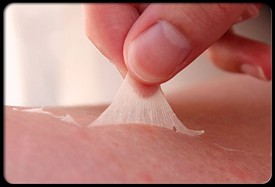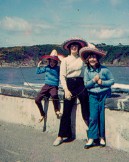A doctor helps with hints for the holiday

The hazards of sunbathing too long. Burnt skin and then peeling.

Coyne and Lanes family take headware protection to Extreme
Edith and Bill Coyne late 1960s
This was the headline of an article giving a Doctor's advice for Newarkers on how to enjoy their holiday break
By Anne Coyne
The newspaper asked how the holiday-maker could prevent their holiday being marred by minor upsets and ailments?
The doctor advised people to enjoy themselves as much as they could, but he also had a few more detailed hints to help with the holiday that was only a few days away. Sickness on the sea trip, a blister on a walker’s heel and sun-burn on the bather’s back, these are the sort of things that destroy much of the holiday-maker’s pleasure.
It was preparations for D-Day that provided the answer for travel-sickness as Hyacine was found to be effective in most cases. In 1954 it was available in a number of different types of proprietory tablets which could be obtained from the chemist without a prescription. It was not effective in every case but was safe for children at the right dosage according to the doctor who gave it to his own children for car sickness.
The doctor advised that the main danger for hikers and cyclists was the danger of blisters. The best advice for blisters is to avoid them said the doctor. Shoes should fit properly and have no projecting nails or rough seams; he also added that if socks are always thoroughly clean blisters are unlikely. He advised the public to remember the old boy scout habit “Soak your socks as soon as you get them off”.
The newspaper then went onto describe how each year the medical authorities warn the sun-starved British public not to expose themselves to too much sun. The paper said that every year thousands of seaside visitors turn themselves from parchment white to painful lobster-red on the first day of their holidays and spend the next week regretting it.
The advice given was that a few minutes sun-bathing was enough for the indoor worker on the first day. The subsequent advice was to increase this to half an hour on the second day and then gradually increase exposure as the holiday went on. The doctor also advised to keep lightly covered or in the shade at all other times.
He said some people get quite badly burned on the first day, and the chances are that they have come straight out the sea and allowed the sun to dry them. Dry salt increased the risk of burning it was advised.
The doctor also went on to advise about bathing, he advised to make sure you were warm before entering the water and not to stay in for more than half an hour to avoid the risk of cramp. He also warned about not swimming soon after meals.
He said a short dip in the shallow end of the bathing pool was fine, but if you intended to swim out of your depth in the sea then you should allow a couple of hours prior to the swim. The theory was that the process of digestion diverts the blood supply from the limbs leading to cramp in cold water. It was also suggested that it had the effect of diverting blood away from the brain and caused fainting which would be dangerous in water.
The doctor was finally asked what sort of clothing would he recommend for a holiday. He responded that this was a matter of personal preference and fashion rather than medicine.
The minor holiday ailments covered in the article are still relevant today, particularly the warning about the risks of too much sun bathing and the associated medical risks. I am not sure about what is currently prescribed for travel sickness but this still affects a portion of the population and can be miserable for the holiday traveller.
Click here to go to the next article in this series